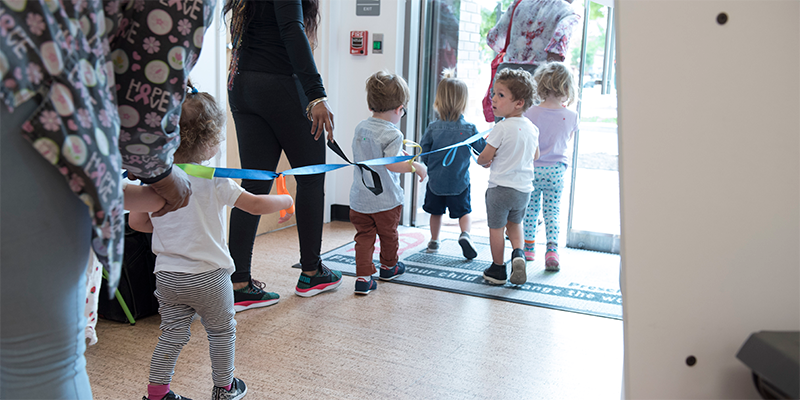
Throughout the year, CCAoA monitors the latest, most important research findings about child care. The information deserves a wide audience, so we’re launching Child Care Research: Year in Review to share some of the most significant studies from the past year.
It would be impossible to talk about all the research topics covered in 2019. Instead, we’re focusing on the issues that CCAoA has been writing and thinking about in the past year:
- The child care workforce
- Subsidies
- Children’s social-emotional health
- The supply of child care
That said, a dominant theme in 2019 research is the inequity within the child care system. Providers earn much less than workers in other professions. Children with special needs have reduced access to child care subsidies. Traumatized children have higher rates of suspension and expulsion. Not all the findings were negative, though. Some studies showed the positive changes that can happen when children have access to child care and providers get the support they need.
In addition to the challenges in child care and the inequities noted, we found some innovative programs and resources that aim to solve those problems. And at the end of each topic area, we list questions we hope the research in the year(s) ahead will address. Be sure to take a look.
 Child Care Workforce
Child Care Workforce
The early care and education workforce is in crisis. Child care professionals struggle because of low wages, a lack of support for their career growth through education and professional development and a society that frankly undervalues them.
One example: Although not causally linked, as teachers have upped their levels of education and experience, their wages have shrunk. Turnover is high and some providers – especially home-based providers – are exiting the field altogether. CCAoA’s own research shows that between 2017 and 2018, a whopping 83% of states had a drop in the number of family child care providers and about half (48%) had a drop in the number of centers.
There are a lot of reasons for the high turnover. Many providers, like other low-income workers, report high levels of stress and depression, which can affect their ability to do their jobs well. Teachers with fewer symptoms of depression reported less job-related stress. Among other things, they were more likely to use teaching practices that promote children’s learning and development. One 2019 study showed that caregivers who could recognize and regulate their own emotions tended to form close, supportive relationships with children.
What does the child care workforce need? In addition to more equitable compensation, they need training and support so they can improve the quality of their programs. In Delaware, family child care providers who participated in a state quality improvement initiative doubled their chances of advancing to the next level of QRIS. Minnesota providers enrolled in a training program were more likely to implement best practices in nutrition and physical activity.
Another way to boost program quality and ease the burden on teachers is to make better use of ECE assistant teachers.
Innovations
|
 Subsidies
Subsidies
Research shows that access to child care subsidies help low-income mothers and families by offering them the chance to work or go to school.
Who’s affected by subsidy policies?
The Child Care and Development Block Grant (CCDBG) requires states to focus their efforts on certain populations at risk — families with very low incomes, homeless children and children with special needs. States must identify children in these categories, make sure they have access to subsidies and explore solutions that break down barriers to access. That’s the goal.
But state-level policies and practices can affect who receives subsidies. Read about a group of states whose policies discourage eligible Hispanic families from applying for subsidies.
What about children with special needs? It turns out they use subsidies at far lower rates than their peers without disabilities. If a child with disabilities does receive a subsidy, it affects the number and types of care that parents choose.
What are the benefits of subsidies?
Subsidies decrease the number of child care arrangement families must cobble together for their children. Otherwise, some children might spend time in a center, a home, and with a family member — all in one day. Fewer settings is good for children, because research shows that multiple child care arrangements can lead to poorer behavior.
Mothers who receive subsidies are more likely to increase their level of education over time. Why? With their young ones in child care, mothers can devote time to other activities such as schooling.
Subsidies also seem to play a role in stabilizing the lives of some low-income mothers. Take women who experience intimate partner violence. In general, they are more likely to miss work or lose their jobs. But those who receive subsidies have the same level of work stability as women not experiencing intimate partner violence.
Subsidies seem to be a protective factor for low-income women. Mothers in Illinois were less likely to be reported for the physical abuse or neglect of their children. Subsidies also are associated with fewer reports of supervisory child neglect (e.g., leaving children home alone).
Innovations
CCAoA Research Recommendations:
|
 The Social-Emotional Health of Children
The Social-Emotional Health of Children
Health and safety discussions often focus on visible hazards such as broken toys and playground equipment, or on infectious diseases in child care. We at CCAoA have a broad definition of health that includes young children’s mental health, often called social-emotional health.
Many children in child care have experienced or are experiencing adverse childhood experiences (ACEs). ACEs are linked to a host of negative outcomes. Children in child care with high ACEs scores often demonstrate challenging behaviors. They are more likely to be suspended or expelled, which can be harmful to the children and can wreak havoc on parents’ work and/or school schedules.
Some ECE programs are implementing strategies to address trauma and promote children’s well-being. A social skills program in Montreal led to decreases in children’s levels of cortisol (the stress hormone). Lower stress is good for all children, but especially those who have experienced trauma.
Innovations
CCAoA Research Recommendations:
|
 Supply of Child Care
Supply of Child Care
Across the U.S., there is a significant gap between the demand for affordable, high-quality child care and the supply of child care slots.
The child care supply crisis is a huge issue for CCAoA. We’ve studied child care supply and demand in many states through our Mapping the Gap work. Other researchers are also interested in the topic and are trying to measure gaps in child care supply and assess their impact.
One 2019 study found a link between the supply of child care and children’s school readiness. More child care was associated with better literacy scores. In New Jersey, Head Start programs play a big part in reducing child care supply gaps, especially in less urban and less populous portions of the state.
Certain groups of people are more affected by the child care supply crisis than others. Some parents of young children try to improve their economic prospects through higher education. However, community colleges can fail these student-parents by not offering affordable child care options. For low-income single mothers working non-standard hours (outside the 9 a.m. – 5 p.m. timeframe), finding available, stable child care is complex. Young children benefit from consistent child care (i.e., children have the same teacher, same setting, same routines), which can lead to fewer behavioral problems and higher social competence.
Innovations/Solutions
CCAoA Research Recommendations:
|
Summary
If there’s a common thread to the studies from 2019, it’s the issue of equity. It is central to almost any conversation about child care and is one of the key goals of CCAoA’s Policy Agenda. Among other things, we need:
- Equitable subsidy assistance for families trying to afford child care.
- Equitable access to quality child care regardless of income, race, cultural background or geography.
- Equitable child care options for parents who work nonstandard hours.
- Equitable resources to care for the social-emotional health of our children and support for the people that provide their care.
- Equitable opportunities to recruit early childhood educators from underserved communities.
- And of course, equitable compensation for the child care workforce.
Let us know what you think about Child Care Research: Year in Review. Your feedback will help us make next year’s edition even more useful. Please email us at research@usa.childcareaware.org.





